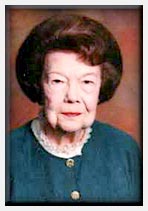The Original Swastika Symbolized Well Being & Good Fortune |
|
 Eloise Lane
Eloise Lane
The original swastika symbolized well being and good fortune (The museum appreciates the information sent by Diane Veledey from the Chamber of Commerce in Raton, New Mexico.) A recent visitor to the White Deer Land Museum was very agitated because he had seen a swastika in this area. Like those whose memory goes back to World War II, he associated the swastika with the hate, antisemitism, death and murder of Adolph Hitler's Nazi Party. But the swastika -- with an entirely different meaning -- has been known and used by many cultures around the world for many years. Artifacts, such as pottery and coins from ancient Troy, show that the swastika was a commonly used symbol as far back as 1000 B.C. The original word is "svastika," a word in Sanskrit, the carefully constructed classical language of the Hindus. The "av" means "good;" "asti" means "to be" and "ka" is a suffix. The swastika, meaning "well being," has been used for more than three thousand years to represent the sun, power, strength and good luck. The form of the swastika is an adaptation of the Greek cross which has an up- right and ~ transverse shaft equal in length and intersecting at their middles. The swastika has each of its four arms bending at midpoint and extending at right angles all in the same rotary direction. The bent arms may extend clockwise to the right or counterclockwise to the left. If the bent arms extend counterclockwise, the swastika looks like a formation of four capital L's. In the mid-nineteenth century, German nationalists began to use the swastika because it had Aryan/Indian origins. This symbol became the official emblem of the Nazi Party on August 7, 1920, at the Salzburg Congress. But even in the early twentieth century, the swastika was still a symbol with positive connotations. It was a common decoration on cigarette cases, postcards, coins and buildings. During World War I (1917-1918), the swastika could be found on the shoulder patches of the American 45th Division. The symbol was used by the Finnish air force until after World War II (1941-1945). The swastika, meaning "good fortune," was widely used by the Indians in New Mexico as a means of giving directions. In ~ a post office was established at Swastika, a coal-mining town five miles west of Raton in Dillon Canyon. The Gardiner-Swastika branch of AT&SF PP once extended from Dillon to Swastika, In the 1930s, people from this area became interested in the scenic attractions of New Mexico, particularly around Eagle Nest. They frequently stopped at Raton and became aware of the swastika and its Indian meaning of "good fortune." Some thought that this symbol was appropriate to use when constructing their houses. Records in Wheeler County (Texas) show that the counterclockwise swastika was recorded as a cattle brand in 1936. By 1940, swastikas had almost completely disappeared in the southwestern United States. The name of the coal-mining town of Swastika was changed to Brilliant in 1940. The swastika cattle brand in Wheeler County was rearranged to form the initial capital letter of a family name. However, a Swastika Hotel still (in 2004) exists in Paton, New Mexico. It is very sad that the swastika which originated as a symbol of well being and good fortune has become a symbol of hate and death. There is a movement to differentiate the two meanings of the swastika: the clockwise Nazi version to mean hate and death and the counterclockwise version to represent the ancient meaning of the symbol - well being and good fortune.

